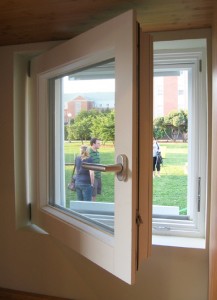Solar Decathlon Pre-Competition Update
Sairaj Dhople with adviser Patrick L. Chapman
The University of Illinois’s entry for the 2009 Department of Energy’s Solar Decathlon in Washington, D.C., is the Gable Home, with a distinctive roofline characteristic of rustic barns in mid-west America. It captures the essence of the Midwest in more ways than meet the eye; the siding is wood reclaimed from a barn in Rockford, Illinois, and the decking material was obtained from a demolished grain silo in Champaign, Illinois. In recycling and restoring material from barns and silos in its backyard, the team has maintained the ideals of sustainability with an emphasis on local vernacular architecture.
While the exterior of the house reflects the simple yet aesthetically pleasing nature of a barn, the technical features are oriented towards the future. The Gable Home meets Passive House standards, (see http://www.solardecathlon.uiuc.edu/gable.html#passivehouse) an involved and rigorous performance metric that demands environmental sensitivity in terms of energy efficiency. To help reach this target, the house incorporates more insulation than customary, advanced triple-pane windows (see Figure 14) with a predominantly southern exposure and a state of the art installation procedure.
The solar photovoltaic (PV) power system is designed from both a power generation and an aesthetic standpoint. The team preferred to blend the PV system into the building design without sacrifice of architectural objectives. The solar array is placed at nearly the optimal angle for solar harvest, fills the southern roof space, and provides far more than enough power to balance the building energy (while energy balance can be achieved with a 6 kW system, the available roof space allows for mounting a 9 kW array). The final design is the product of many back-and-forth tradeoffs on roof size, PV peak power capability, roof pitch, cost analysis, energy analysis, PV module technology, and ease of installation (see Figure 15). SunPower SPR-225-BLK panels are utilized in the Gable Home.
These modules are very efficient, reasonably priced and furthermore, due to SunPower’s proprietary production methods, they have a nearly solid black appearance that is aesthetically pleasing compared to conventional PV modules, which tend to have visible metallization and a degree of purplish tint.
The Gable Home also allows homeowners to monitor and control energy use in real time. Automated control of individual receptacles and switches is provided. Additionally, the power draw of every circuit in the house can be monitored. LED light fixtures are employed to maximize energy efficiency. A touch-screen computer provides an easy-to-use graphical user interface for control of and monitoring the home automation systems (see Figure 16). Also, this interface provides a digital thermostat to control indoor temperature and humidity.
More than two years of design, planning, implementation, and testing have shaped the Gable Home to its final form (see Figure 17). Over 200 students from more than 10 disciplines have worked tirelessly towards the short-term goal of winning the competition and an equally important long-term goal of ushering in a greener future. The team thanks all its supporters, sponsors and partners and wishes to dedicate the home to future generations of students interested in sustainable design and energy efficiency.
The 2009 Solar Decathlon is supported in part by the Illinois Clean Energy Community Foundation, the National Renewable Energy Laboratory, the College of ACES, Valcucine, Texas Instruments, and the Grainger Center for Electric Machines and Electromechanics.



